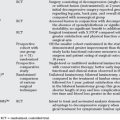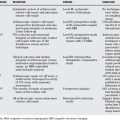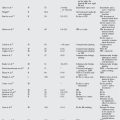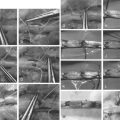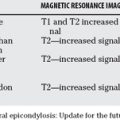Chapter 65 Tibial Diaphyseal Fractures: What Is the Best Treatment?
The management of tibia fractures has evolved over time from nonoperative treatment to operative treatment. Despite their common occurrence, the evidence base to direct the care of tibial shaft fractures is relatively poor. Moreover, there is little evidence to support the commonly recommended parameters of acceptable fracture alignment (less than 5–7 degrees of varus/valgus, less than 10 degrees of flexion/extension, less than 1.5 cm of shortening, and less than 15 degrees of rotational deformity). The characteristics of fractures amenable to nonsurgical management, stable fractures, are not well evidence based. It is generally accepted that nonpathologic, isolated, low-energy fractures, with little displacement, no significant soft-tissue injury, and having an associated fibular fracture can be treated without surgery. For the surgical management of tibial shaft fractures, a variety of implants is available, including external fixators, plates, and intramedullary (IM) nails.
OPERATIVE VERSUS NONOPERATIVE TREATMENT OF DISPLACED TIBIA SHAFT FRACTURES
Minimally displaced, stable tibia shaft fractures are commonly treated without surgery with satisfactory results. Controversies, however, exist in the management of displaced tibial shaft fractures. Six studies have compared nonoperative treatment modalities with surgery for displaced closed tibia fractures.1–7
NONOPERATIVE TREATMENT VERSUS OPEN REDUCTION AND FIXATION WITH PLATES AND SCREWS
In a prospective randomized clinical trial by Abdel-Salam and colleagues,1 45 patients with closed tibial shaft fractures were treated with a long-leg plaster cast and compared with 45 patients managed with open reduction and internal fixation (ORIF).1 Healing time and return to usual activity was significantly shorter in the ORIF group. The complication rate of secondary intervention for bone grafting or deep infection was lower in the ORIF cohort.
In a similar study by van der Linden and Larsson,7 100 patients were randomly assigned to ORIF with plates or closed treatment. Hospital stay seemed to be longer in the group treated by ORIF, and the complication rate was slightly greater. In accordance with Abdel-Salam and colleagues’ study,1 the healing time was significantly shorter in the ORIF group, and malalignment occurred more frequently in the nonoperative group.
A meta-analysis that included these studies reached the conclusion that the quality of the literature was poor. The risk for superficial infection was greater after ORIF versus cast treatment (odds ratio, 0.2; 95% confidence interval [CI], 0.08–0.50); however, there was no difference in the deep infection rate. Fractures treated with ORIF were more likely to be healed by 20 weeks than those treated in a cast (odds ratio, 0.02; 95% CI, 0.06–0.68).8
NONOPERATIVE TREATMENT VERSUS INTRAMEDULLARY NAIL
Hooper and coworkers’4 prospective, randomized study of 62 patients with unstable tibial shaft fractures found that IM nailing reduced time to fracture union by 2 weeks (P < 0.05) compared with long leg casting. IM nailing was also associated with significantly less time off work (13.5 vs. 23 weeks; P < 0.01) and less time in the hospital (8.1 vs. 11.7 days; P < 0.01). Compared with IM nailing, more patients with cast treatment had angular deformity and shortening. One third of casted patients healed with more than 10 degrees of angular deformity, and two thirds with shortening of more than 1 cm. No significant differences were observed in regard to range of motion of the ankle or knee joints. Secondary interventions were necessary in five patients of the nonoperative group compared with only one patient in the ORIF group.
Toivanen and coauthors6 note no delayed union in 33 patients treated with IM nailing compared with 8 of 54 patients treated with cast, representing a delayed union rate of 14.8% (P < 0.05). They did note anterior knee pain in 79% of patients treated with an IM nail compared with only 2% in the casted group (P < 0.001). Mean healing time, hospitalization time, and sick leave duration were significantly longer in the group treated with casting. A significant bias in this study was that patients initially treated without surgery who had a loss of reduction and needed revision surgery were excluded, so that the results in terms of final alignment were not statistically different between the groups. In a prospective, randomized trial, Karladani and researchers5 studied 53 patients, with 27 being treated with IM nails and 26 receiving nonoperative care. The nonoperative group was divided into additional cohorts of 12 and 14 patients because some fractures were not considered stable enough to be treated in cast alone and underwent cerclage wire or screw fixation in addition to casting. In the analysis of the final outcome parameters such as quality of life, weight-bearing time, and union rate, these two groups were analyzed together and compared with the IM nail group. IM nailing resulted in a 6 weeks faster time to union (95% CI, 2.5–12 weeks), and a faster time to full weight bearing by 8 weeks (95% CI, 5–17 weeks). IM nailing was associated with a lower risk for delayed union (odds ratio, 0.36; 95% CI, 0.17–0.78) but an increased risk for anterior knee pain (12/27 vs. 0/26 patients). At 3 months after injury, patients who underwent IM nailing had significantly better mobility, social function, work function, and sexual function as measured on the Nottingham Health Profile (P < 0.05).
OPERATIVE TREATMENT OF CLOSED TIBIA FRACTURES
Plate versus Intramedullary Nail
A prospective, randomized trial with a total of 64 patients was conducted by Im and Tae9 to compare IM nailing to plate fixation of distal tibia fractures. Thirty-four patients were treated with an IM nail, and 30 patients underwent open reduction and plate fixation with a follow-up period of 2 years. In the group treated with IM nails, the average angulation was greater (2.8 vs. 0.9 degree; P = 0.01). Locked IM nails seem to be advantageous in regard to the length of operation, restoration of motion, and reduced soft-tissue complications, whereas open reduction and fixation with plate and screws can restore alignment better than IM nails.
A systematic review of the prospective literature by Coles and Gross10 reports more superficial infection with plating (9% vs. <3% with reamed vs. unreamed nailing) but lower rates of malunion (0% vs. 3.2% with reamed and 11.8% with unreamed nailing). No evidence that assesses the utility of minimally invasive plating techniques in comparison with other treatment approaches is currently available.
Intramedullary Nail versus External Fixator
A total of 78 patients with 79 fractures was entered into Braten and coworkers’11 study (41 external fixators, 38 IM nails). Time to radiographic union and full weight bearing did not differ significantly, but unprotected weight bearing was achieved earlier in the IM group (12 vs. 20 weeks; P < 0.001). Reoperation for secondary displacement was more frequent in the external fixator group. No differences were observed in the final alignment or in the amount of shortening. IM nailing was commonly associated with anterior knee pain.
Intramedullary Nail versus Ender Nail
In a study by Chiu and colleagues12 that compares Ender nails with locked IM nails, IM nails were found to be superior for the treatment of comminuted, unstable tibial shaft fractures.
Reamed versus Unreamed Intramedullary Nails
Four Level II studies could be identified in which unreamed nailing was compared with reamed nailing.13–16 Reamed nailing was consistently found to be superior compared with unreamed nailing. The incidence of delayed and nonunion, as well as malunion, was lower, secondary interventions were less frequent, and the overall healing time was shorter in the group treated with reamed IM nails. Implant failure was found to be more frequent with unreamed nailing, whereas no difference in infection rate was encountered.
OPEN FRACTURES
Early versus Late Treatment
Three retrospective cohort studies could be identified to determine the efficiency of early surgical treatment versus delayed treatment in open tibia fractures.17–19 The final outcome measures included infection, secondary procedures, nonunion, and delayed union. Early surgery was defined as surgery less than 6 hours after the injury, whereas delayed surgery was defined as greater than 6 hours. In both groups, antibiotics were administrated. No differences in the overall rate of infection, secondary procedures, nonunion, delayed union, or complications could be determined. Although the present consensus remains that open tibial shaft fractures be treated on an emergent basis (Level V), if unavoidable, delayed management does not seem to jeopardize the final outcome.
Plate Fixation versus External Fixator
In Bach and coauthors’ study,20 published in 1989, a total of 59 patients were randomized to undergo plate fixation or external fixation for grade 2 and 3 open fractures.20 Their study showed a statistically significant greater rate of deep infections in the group treated with ORIF. Time to union and malalignment was not significantly different in both groups. Additional lag screws were used in 12 of 26 patients with external fixation for better alignment. This procedure did not seem to have any adverse effects in regard to the healing time or secondary procedures. This is in contrast with Krettek and colleagues’21 study in which they recommend that additional lag screws not be used in open tibia fractures treated by external fixators because they seem to interfere with bone healing.
Locked Intramedullary Nail versus External Fixator
In the evolution of the treatment of open tibial fractures, a strategy of sequential locked IM nailing after external fixation was developed. Antich-Adrover and investigators22 evaluated this strategy in a prospective, randomized study of 39 patients. Sequentially treated patients healed faster, with better alignment, and had a more predictable and rapid return to full function than patients treated with external fixation followed by casting.
In a prospective, randomized study of grade II, IIIA, and IIIB open fractures, Henley and coworkers23 suggest that unreamed interlocked IM nailing was more efficacious than half-pin external fixation. IM nailing was associated with significantly better final alignment and significantly less operative interventions. Healing complications and infections were more associated with the severity of the soft-tissue injury than the method of skeletal stabilization.
Two Level III trials with a total of 65 patients and 1 Level III study with 41 patients evaluated unreamed nailing and external fixation in higher grade IIIB fractures.24–26 Patients who underwent nailing were easier to manage, required less secondary procedures, and had more predictable anatomic outcomes, without having greater infection risks.
Reamed versus Unreamed Locked Intramedullary Nailing
Reaming has been the source of much debate in the management of tibial shaft fractures. An extensive body of basic science literature exists regarding this topic. Hupel and coauthors27 conclude that “limited canal reaming before insertion of an intramedullary nail may result in the least damaging combination of insults to the cortical circulation.”
Two trials, with a pooled 132 patients, have evaluated reamed versus unreamed nails in open tibial shaft fractures in a prospective, randomized fashion.15,28 The outcomes in terms of nonunion or infection were not influenced by reaming. There was, however, a statistically greater rate of implant failure associated with the use of an unreamed nail.
TECHNICAL CONSIDERATIONS
Fracture Table
Although early in the history of tibial nailing the use of a fracture table was usual, there has been a gradual move away from this. A prospective, randomized study29 demonstrated that “free-draped” nailing was equally effective as using a fracture table and required less operative time. It also facilitated concomitant injury management. Although fluoroscopy time was no different, it may be that the surgeon exposure, not measured, was higher because of the requirement of being closer to the field in the free-draped technique. It should be pointed out that free-draped nailing generally requires an assistant, whereas fracture table nailing can usually be done without one. An external fixation device can be used as a temporary intraoperative reduction aid during nailing without a fracture table, but it has not been evaluated objectively.
Tourniquet
A generally held belief is that a tourniquet should not be used while reaming because it is theoretically postulated that the circulatory system acts as a radiator, dissipating the heat generated and preventing heat necrosis of the diaphysis, a devastating complication of reamed nailing. A prospective, randomized study by Giannoudis and coworkers30 does not substantiate this concern. There was a slightly, but not statistically significant, higher temperature with the use of a tourniquet, but aggressive reaming was not carried out. The authors did, however, find that diaphyseal temperatures increased most with the larger reamers (11 and 12 mm) and in small medullary canals. Blood loss with IM reaming is usually small, so unless there are particular concerns, a tourniquet is not usually needed.
Approach and Starting Point
A move has been made to a less invasive, percutaneous technique of nail insertion, although no evidence demonstrates a benefit. The starting point for the insertion of a tibial IM nail has been the source of much discussion and debate. The two principle issues at play are the incidence of anterior knee pain and effects of start point on fracture alignment. Toivanen and coauthors31 could demonstrate no difference in the incidence of late anterior knee pain or functional impairment with the use of a paratendinous versus a transtendinous approach. These findings are consistent with a body of evidence of lower quality.
The nailing of proximal-third tibial fractures has been associated with a significant incidence of malunion, valgus, and procurvatum. This has been related to the anatomy of the proximal tibia and to nailing with the knee in flexion. The oblique anteromedial face of the proximal tibia will direct a nail started medially and anteriorly in a posterolateral direction. Once centered in the canal of the distal segment, this will result in a valgus, procurvatum deformity. This malalignment can largely be avoided by a lateral and more posterior starting point. Indeed, the safe starting point has been delineated by McConnell and researchers32 as being just medial to the lateral tibial spine, at the anterior edge of the articular surface of the tibial plateau.
Other strategies can be used to manage the tendency toward malalignment in difficult cases. This includes nailing in extension,33 the use of “poller” blocking screws,34 temporary limited plating, or entirely avoiding nailing and using definitive plating techniques.35 Nailing in extension overcomes the tendency to flex the fracture, produce procurvatum, with nailing with the knee maximally bent. Blocking screws are screws (can also be pins) placed percutaneously across the tibia to narrow the medullary canal, thus directing the nail into proper alignment. These are effective only in the metaphyseal portion of the tibia where the nail is not constrained by the medullary canal. They are also unable to compensate for an entirely wrong starting point. Unicortical plating through a limited approach, preserving bone vascularity, can aid by maintaining fracture alignment while nailing and locking is undertaken. The plate can be left definitively or can be removed once locking has been accomplished. Leaving the plate is technically against basic principles because nails generally provide relative stability, whereas these plates confer absolute stability. Surgeons with limited experience with nailing of proximal-third fractures may well consider using definitive plating techniques rather than nailing. No good evidence base exists for the selection of approaches to the management of proximal-third tibial fractures.
Locking
It is generally recommended that all tibial nails be locked proximally and distally. With stable transverse fracture patterns, the screws at one end can be placed in a dynamic mode, if the nail design allows, because one requires only rotational control and not axial control. In fractures in the midthird, one screw at each end of the nail is sufficient to control bony alignment. As the fracture approaches the metaphyseal area, because of the limited cortical bony contact, more than one locking screw in the short segment affords better angular stability. Kneifel and Buckley36 prospectively evaluated the use of one versus two distal locking screws in diaphyseal tibial fractures treated with undreamed nails and showed a significantly greater screw failure rate with the use of only one screw. Heavier patients and longer locking screws (larger medullary canals) correlated with increased screw failure. This, however, had no impact on fracture union.
Although free-hand distal targeting is most commonly used for distal locking, two prospective, randomized studies compared the use of alternative devices. Gugala and coworkers37 demonstrated no significant difference in operating time with the use of a distally based distal targeting device and no statistical difference in total fluoroscopy time. They did show a statistically shorter distal-locking fluoroscopy time with the distal device. Krettek and colleagues38 showed a statistically shorter operative time and fluoroscopy time with their radiation-independent distal aiming device.
Fibular Plating
Some debate regards the merits of stabilization of an associated fibular fracture in distal-third tibial fractures. Clearly, if the fibular fracture represents an associated ankle fracture, the principles appropriate to ankle fractures should be applied. A retrospective, Level III study by Egol and coauthors39 suggests a significantly lower rate of loss of alignment in nailed distal-third tibial shaft fractures when ORIF of the fibula was also undertaken.
Postoperative Management
In the postoperative management of nailed tibial fractures, there is little evidence base to direct care. The use of splints, the role of physiotherapy, and the time to weight bearing have not been evaluated. Although there is some support for the use of deep vein thrombosis prophylaxis in tibial fractures treated in cast, no evidence is available to direct prophylaxis in cases with surgical stabilization.
Bone Healing Adjuncts
Low-intensity, pulsed ultrasound has been shown to be effective in accelerating tibial shaft fractures treated without surgery in well-constructed studies40,41; however, they found no effect in the use of this modality in tibial fractures treated by IM nailing in a prospective, randomized, double-blinded, placebo-controlled study of 32 patients. Interferential current treatment to reduce tibial shaft fracture healing time has also proved to be ineffective.42
1 Abdel-Salam A, Eyres KS, Cleary J. Internal fixation of closed tibial fractures for the management of sports injuries. Br J Sports Med. 1991;25:213-217.
2 Ali SA, Mehboob G. Comparative study ‘pin and plaster’ and ‘AO monoplane external fixator’ in treatment of gustilo type I and II open fracture of tibia. J Coll Physicians Surg Pak. 2002;12:741-742.
3 Curtis JF, Killian JT, Alonso JE. Improved treatment of femoral shaft fractures in children utilizing the pontoon spica cast: A long-term follow-up. J Pediatr Orthop. 1995;15:36-40.
4 Hooper GJ, Keddell RG, Penny ID. Conservative management or closed nailing for tibial shaft fractures. A randomised prospective trial. J Bone Joint Surg Br. 1991;73:83-85.
5 Karladani AH, Granhed H, Edshage B, et al. Displaced tibial shaft fractures: A prospective randomized study of closed intramedullary nailing versus cast treatment in 53 patients. Acta Orthop Scand. 2000;71:160-167.
6 Toivanen JAK, Honkonen SE, Koivisto AM, Jarvinen MJ. Treatment of low-energy tibial shaft fractures: Plaster cast compared with intramedullary nailing. Int Orthop. 2001;25:110-113.
7 van der Linden W, Larsson K. Plate fixation versus conservative treatment of tibial shaft fractures. A randomized trial. J Bone Joint Surg Am. 1979;61(6A):873-878.
8 Littenberg B, Weinstein LP, McCarren M, et al. Closed fractures of the tibial shaft. A meta-analysis of three methods of treatment. J Bone Joint Surg Am. 1998;80:174-183.
9 Im G-I, Tae S-K. Distal metaphyseal fractures of tibia: A prospective randomized trial of closed reduction and intramedullary nail versus open reduction and plate and screws fixation. J Trauma. 2005;59:1219-1223.
10 Coles CP, Gross M. Closed tibial shaft fractures: Management and treatment complications. A review of the prospective literature. Can J Surg. 2000;43:256-262.
11 Braten M, Helland P, Grontvedt T, et al. External fixation versus locked intramedullary nailing in tibial shaft fractures: A prospective, randomised study of 78 patients. Arch Orthop Trauma Surg. 2005;125:21-26.
12 Chiu FY, Lo WH, Chen CM, et al. Treatment of unstable tibial fractures with interlocking nail versus ender nail: A prospective evaluation. Zhonghua Yi Xue Za Zhi (Taipei). 1996;57:124-133.
13 Blachut PA, O’Brien PJ, Meek RN, Broekhuyse HM. Interlocking intramedullary nailing with and without reaming for the treatment of closed fractures of the tibial shaft. A prospective, randomized study. J Bone Joint Surg Am. 1997;79:640-646.
14 Court-Brown CM, Will E, Christie J, McQueen MM. Reamed or unreamed nailing for closed tibial fractures. A prospective study in Tscherne C1 fractures. J Bone Joint Surg Br. 1996;78:580-583.
15 Finkemeier CG, Schmidt AH, Kyle RF, et al. A prospective, randomized study of intramedullary nails inserted with and without reaming for the treatment of open and closed fractures of the tibial shaft. J Orthop Trauma. 2000;14:187-193.
16 Larsen LB, Madsen JE, Hoiness PR, Ovre S. Should insertion of intramedullary nails for tibial fractures be with or without reaming? A prospective, randomized study with 3.8 years’ follow-up. J Orthop Trauma. 2004;18:144-149.
17 Ashford RU, Mehta JA, Cripps R. Delayed presentation is no barrier to satisfactory outcome in the management of open tibial fractures. Injury. 2004;35:411-416.
18 Charalambous CP, Siddique I, Zenios M, et al. Early versus delayed surgical treatment of open tibial fractures: Effect on the rates of infection and need of secondary surgical procedures to promote bone union. Injury. 2005;36:656-661.
19 Khatod M, Botte MJ, Hoyt DB, et al. Outcomes in open tibia fractures: Relationship between delay in treatment and infection. J Trauma. 2003;55:949-954.
20 Bach AW, Hansen STJr. Plates versus external fixation in severe open tibial shaft fractures. A randomized trial. Clin Orthop Relat Res.; 241; 1989; 89-94.
21 Krettek C, Haas N, Tscherne H. The role of supplemental lag-screw fixation for open fractures of the tibial shaft treated with external fixation. J Bone Joint Surg Am. 1991;73:893-897.
22 Antich-Adrover P, Marti-Garin D, Murias-Alvarez J, Puente-Alonso C. External fixation and secondary intramedullary nailing of open tibial fractures. A randomised, prospective trial. J Bone Joint Surg Br. 1997;79:433-437.
23 Henley MB, Chapman JR, Agel J, et al. Treatment of type II, IIIA, and IIIB open fractures of the tibial shaft: A prospective comparison of unreamed interlocking intramedullary nails and half-pin external fixators. J Orthop Trauma. 1998;12:1-7.
24 Schandelmaier P, Krettek C, Rudolf J, et al. Superior results of tibial rodding versus external fixation in grade 3B fractures. Clin Orthop Relat Res.; 342; 1997; 164-172.
25 Tornetta P3rd, Bergman M, Watnik N, et al. Treatment of grade-IIIb open tibial fractures. A prospective randomised comparison of external fixation and non-reamed locked nailing. J Bone Joint Surg Br. 1994;76:13-19.
26 Tu YK, Lin CH, Su JI, et al. Unreamed interlocking nail versus external fixator for open type III tibia fractures. J Trauma. 1995;39:361-367.
27 Hupel TM, Weinberg JA, Aksenov SA, Schemitsch EH. Effect of unreamed, limited reamed, and standard reamed intramedullary nailing on cortical bone porosity and new bone formation. J Orthop Trauma. 2001;15:18-27.
28 Keating JF, O’Brien PJ, Blachut PA, et al. Locking intramedullary nailing with and without reaming for open fractures of the tibial shaft. A prospective, randomized study. J Bone Joint Surg Am. 1997;79:334-341.
29 McKee MD, Schemitsch EH, Waddell JP, Yoo D. A prospective, randomized clinical trial comparing tibial nailing using fracture table traction versus manual traction. J Orthop Trauma. 1999;13:463-469.
30 Giannoudis PV, Snowden S, Matthews SJ, et al. Friction burns within the tibia during reaming. J Bone Joint Surg Br. 2002;84:492-496.
31 Toivanen JAK, Vaisto O, Kannus P, et al. Anterior knee pain after intramedullary nailing of fractures of the tibial shaft. A prospective, randomized study comparing two different nail-insertion techniques. J Bone Joint Surg Am. 2002;84-A:580-585.
32 McConnell T, Tornetta P3rd, Tilzey J, Casey D. Tibial portal placement: The radiographic correlate of the anatomic safe zone. J Orthop Trauma. 2001;15:207-209.
33 Tornetta P3rd, Collins E. Semiextended position of intramedullary nailing of the proximal tibia. Clin Orthop Relat Res.; 328; 1996; 185-189.
34 Krettek C, Miclau T, Schandelmaier P, et al. The mechanical effect of blocking screws (“Poller screws”) in stabilizing tibia fractures with short proximal or distal fragments after insertion of small-diameter intramedullary nails. J Orthop Trauma. 1999;13:550-553.
35 Matthews DE, McGuire R, Freeland AE. Anterior unicortical buttress plating in conjunction with an unreamed interlocking intramedullary nail for treatment of very proximal tibial diaphyseal fractures. Orthopedics. 1997;20:647-648.
36 Kneifel T, Buckley R. A comparison of one versus two distal locking screws in tibial fractures treated with unreamed tibial nails: A prospective randomized clinical trial. Injury. 1996;27:271-273.
37 Gugala Z, Nana A, Lindsey RW. Tibial intramedullary nail distal interlocking screw placement: Comparison of the free-hand versus distally-based targeting device techniques. Injury. 2001;32(suppl 4):SD-21-SD-25.
38 Krettek C, Konemann B, Farouk O, et al. Experimental study of distal interlocking of a solid tibial nail: Radiation-independent distal aiming device (DAD) versus freehand technique (FHT). J Orthop Trauma. 1998;12:373-378.
39 Egol KA, Weisz R, Hiebert R, et al. Does fibular plating improve alignment after intramedullary nailing of distal metaphyseal tibia fractures? J Orthop Trauma. 2006;20:94-103.
40 Emami A, Petren-Mallmin M, Larsson S. No effect of low-intensity ultrasound on healing time of intramedullary fixed tibial fractures. J Orthop Trauma. 1999;13:252-257.
41 Heckman JD, Ryaby JP, McCabe J, et al. Acceleration of tibial fracture-healing by non-invasive, low-intensity pulsed ultrasound. J Bone Joint Surg Am. 1994;76:26-34.
42 Fourie JA, Bowerbank P. Stimulation of bone healing in new fractures of the tibial shaft using interferential currents. Physiother Res Int. 1997;2:255-268.

